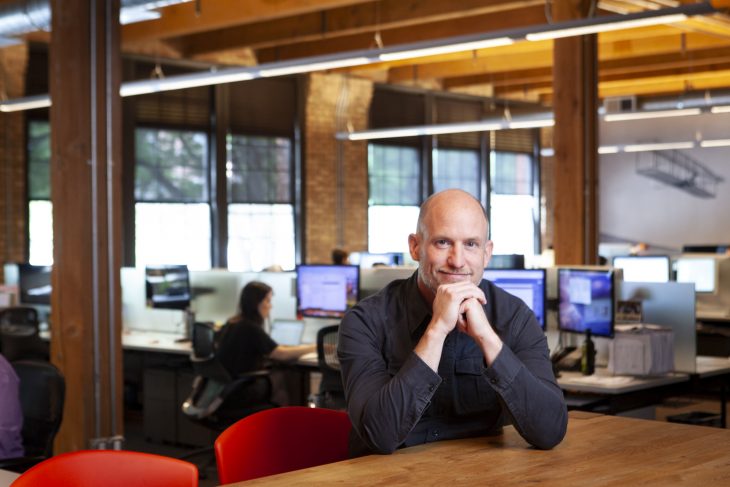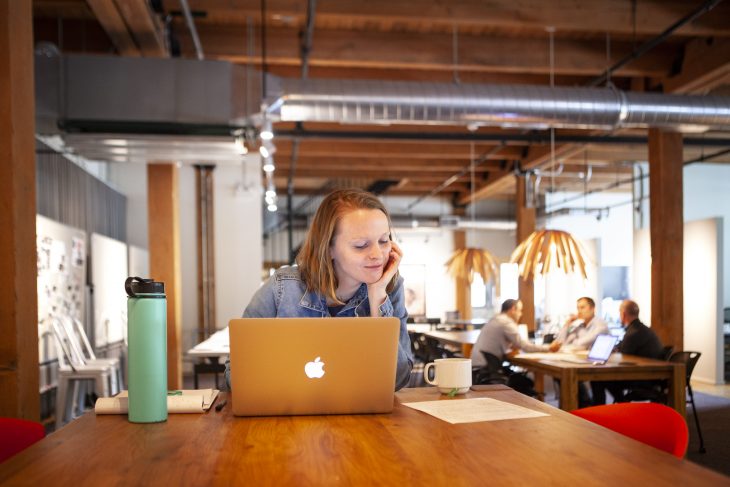50,000feet President Jim Misener discusses how the company’s workspace fosters creativity, teamwork and culture.

Bob Fox: Tell us a little about your business, your work, and your space.
Jim Misener: 50,000feet is a global brand consultancy and creative agency based in Chicago with team in New York. We were founded in 2001, are privately held and are happy to be independent, which allows us to focus on clients and staff rather than outside investors. I’m one of four Principals at 50,000feet. Each of us is charged with developing client relationships and opening conversations with new ones, and we’re also really engaged in the work.
Our team is remarkable in their many talents, and together we take an interdisciplinary approach that combines strategy, creative and technology for compelling, beautiful results. This is important to how we engage with clients and how we work together. With no hard lines between disciplines, we have been able to achieve a high degree of collaboration and cross-pollination, which leads not only to integrated solutions but to meaningful work as well.
Our workspace has a physical footprint of 12,000 square feet across two floors of a commercial loft building, which is the former home of a Lava Lamp factory in a burgeoning creative corridor on Chicago’s Northside. We have an open office environment, and we sometimes use a phrase here: “No walls, no doors, no excuses.” That statement is intended to speak to the ideas of fostering collaboration and accountability no matter what role you play. We encourage listening and learning and trying your hardest, and we aim to perpetuate the great tradition of design studios in our approach to creative problem-solving.
There are 14-foot-high ceilings, worn wooden floors and beams, soft natural light and exposed brick walls. It is also nice to have the flexibility and the benefit of two levels. We try to keep the upstairs a little quieter versus the downstairs where there’s music and a bit of white noise.
In furnishing our office, we celebrate clients, brands and craftsmanship like FLOR, Knoll, HOLLY HUNT, and Sony—curated in a fresh, design-led environment. My fellow Principals are owed the credit for finding the space and continuing to lead its renovation and evolution. As in our work, every detail matters.
Bob Fox: Tell us more about how this kind of openness defines your culture.
Misener: We are constantly bringing new ideas to the table and moving innovation forward, which means we have to be open to different talents, ideas, and perspectives. Integration is huge for us, and our office space reflects that. Great space design needs to deliver the function that’s required of a dynamic, design-driven group of professionals. It also needs to deliver on the aspirational needs of our growing team. Natural light is essential, and the height and comfort of our chairs is as important as the brightness and quality of the overhead lighting.
We think the benefits of hanging work in process, brainstorming in front of white boards and gathering around tables to concept, ideate, and debate can make for more fun and worthwhile process. Everyone on the team is encouraged to share their perspective. It’s in front of the boards that we sometimes find that “aha” moment or discover an approach or solution together that we might not have landed upon alone. The space is designed to feed that sense of discovery and exploration while allowing individuals to return to their desks to work independently.
Bob Fox: Are your teams co-located?
Misener: Everyone sits together, which creates a collective of developers, writers, strategists, and designers that works alongside respective team members who lead client engagements. We try to balance creating a center of gravity for practice teams while also tapping into the benefits of integration across the team as a whole. We find that teams are wrestling with the same kinds of challenges, and getting fresh perspective from a more analytical or creative mind can often lead to better solutions. The design of the space is to provide everyone room to move—and to think. We try to keep the density of concentration areas higher because people are heads-down at their desks versus collaboration areas where there’s a lot of room to move.
Bob Fox: With no walls and no doors, where do you hang your work?
Misener: Rolling whiteboards. A lot of our furniture is movable with flexible configurations. We also have standing desks where people can work, chat, and enjoy a different sightline. We have seated areas for breakouts, plus collaboration and meeting rooms where work gets displayed.
Bob Fox: When you thought about putting the space together, was there a goal that you wanted to accomplish?
Misener: We wanted the space to be a collaborative and creative environment. This is seen in the openness of the space and in the collaborative culture of the office. In terms of how we designed the space, things are modular, and items are light enough to easily move so we can flex up and down as needed. Most of our office systems furniture are made by Knoll, who has been a client for a decade. We’re a huge fan of the workplace innovation and products and services they provide.
Bob Fox: How is your workplace a tool to help your business grow or drive business forward?
Misener: From a business perspective, the idea of adaptability and flexibility has been a nice outcome. When we think of running a company for 17 years, that is quite a long time for a single office to serve as home to a growing company in a dynamic category and a fast-moving world. The office has provided a flexible platform to support growth across our business and to encourage creativity across our team and projects. When you consider how the space and the building has transitioned from factory floor to creative agency, the story gets even more interesting.
Bob Fox: Where do you get the greatest value out of your workplace?
Misener: In addition to the flexibility, we also think about the experience. Your question cues up what feelings are brought out when you step inside our workplace. We also want it to be inviting and comfortable. We want people to think, “This is a really awesome place.” The workspace is meant to support and not interrupt how our employees want to work. We are always trying to tweak things to make it fit better.
Bob Fox: As a branding/communications firm, is there a way that you use the space to communicate your message or what you do?
Misener: We don’t overtly brand the space with our own work. What you will see is that the space exudes creative energy while also adhering to a certain sensibility that keeps us aligned, inspired, and moving forward. Clients tell us that when you step in, you will feel like you’re in a space where creativity happens and that you are part of an idea-making machine. It’s powerful when we can convey that experience and impart that feeling throughout the whole environment.
Bob Fox: How influential do you think your space is in attracting talent and prospective clients?
Misener: For our staff and clients, we do everything we can to make for the best place possible. Close to transit, restaurants, and out of the fray of downtown, we wanted to create a space that’s accessible and that people want to be in. There are benefits to being in a real neighborhood where a sense of peace and calm gives us the headspace to do great work. The idea of ease, inspiration, and comfort is really important. We feel at home here.







